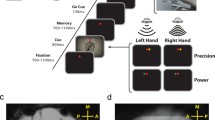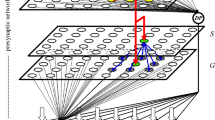Abstract
In the first part of this article, we review our neurophysiological studies of the hand-manipulation-related neurons in the anterior part of the lateral bank of the intraparietal sulcus (area AIP) . We describe the properties of visually responsive neurons in area AIP. Object-type visual-dominant neurons responded to the sight of objects and showed selectivity not only for simple geometrical shapes, but also for complex objects such as a knob-in-groove and a plate-in-groove. Some of the object-type visual-dominant neurons showed selectivity for the orientation of the longitudinal axis or the plane (surface) of a plate or a ring. In the second part of this article, we review our study of binocular visual neurons in the caudal part of the lateral bank of the intraparietal sulcus (c-IPS area), in particular, of axis-orientation-selective (AOS) neurons and surface-orientation-selective (SOS) neurons. AOS neurons preferred long and thin stimuli, were sensitive to binocular disparity, and tuned to the axis orientation in three-dimensional (3D) space. SOS neurons preferred broad and flat stimuli and were tuned to the surface orientation in depth. Some SOS neurons responded to a square in a random dot stereogram (RDS) with orientation tuning, suggesting that they encode surface orientation from a disparity gradient. Others responded to solid figure stereograms with orientation disparity and/or width disparity. It was concluded that the c-IPS area is a higher center for stereopsis, which integrates various binocular disparity signals received from the V3 complex and other prestriate areas to represent the neural code for 3D features. It may send projections to the AIP area and contribute to visual adjustment of the shape of the handgrip and/or hand orientation for manipulation and grasping. Neurons of the AIP area may also receive monocular cues of depth from the ventral visual pathway to discriminate the 3D shape of the object of manipulation.
Similar content being viewed by others
Author information
Authors and Affiliations
Additional information
Received: 21 September 1998 / Accepted: 23 March 1999
Rights and permissions
About this article
Cite this article
Sakata, H., Taira, M., Kusunoki, M. et al. Neural representation of three-dimensional features of manipulation objects with stereopsis. Exp Brain Res 128, 160–169 (1999). https://doi.org/10.1007/s002210050831
Issue Date:
DOI: https://doi.org/10.1007/s002210050831




